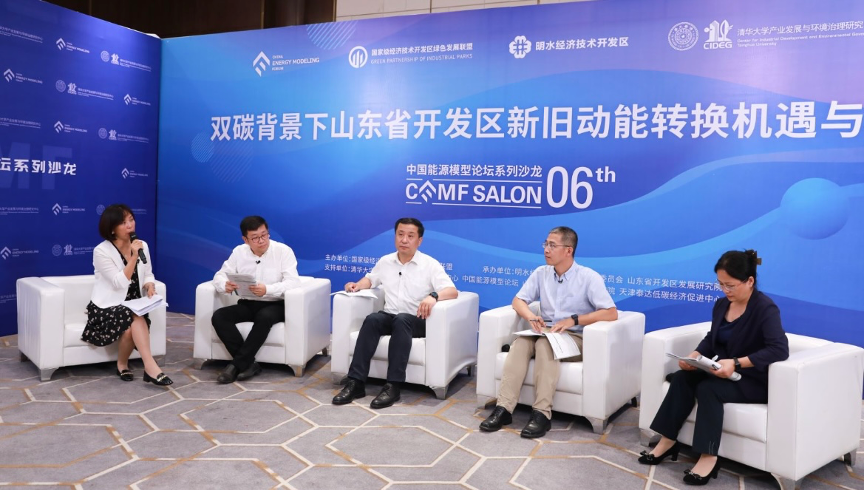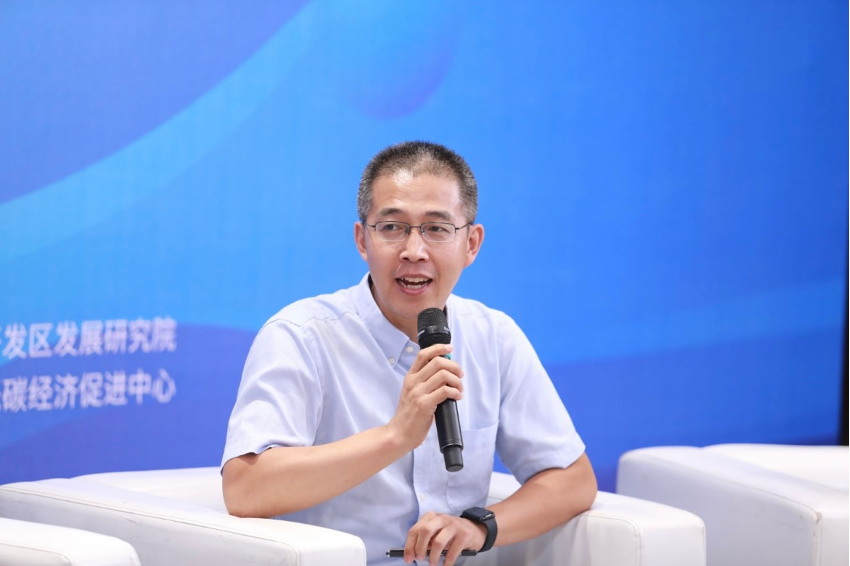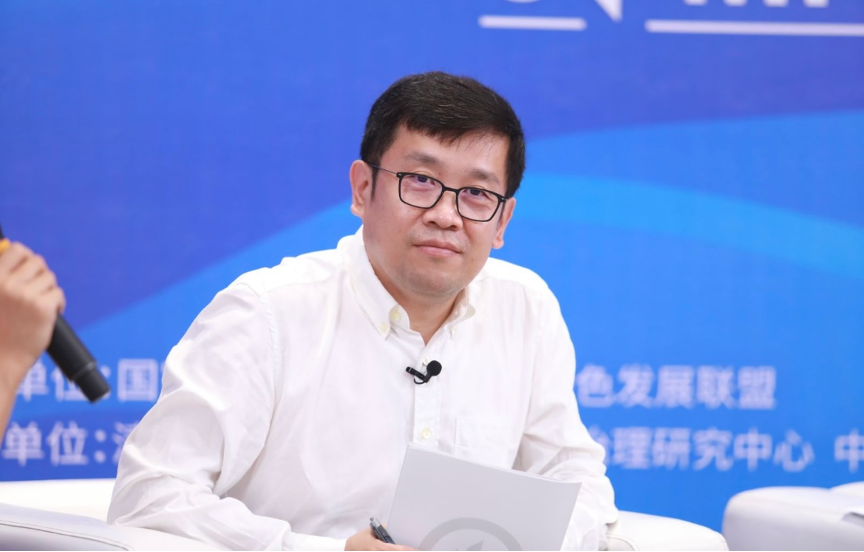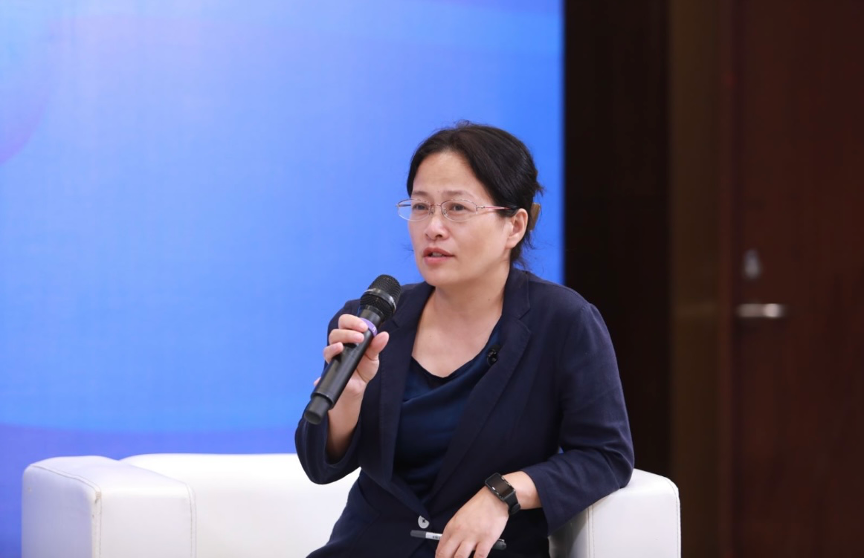On September 20th, the China Energy Model Forum (CEMF) hosted the sixth salon around the theme of "Opportunities and Challenges for the Transformation of Old and New Kinetic Energy in Shandong Province in the Dual Carbon Context." This salon, also the 187th academic salon of CIDEG, shared research progress and practical experiences related to the development zones' efforts to deepen the transformation of old and new kinetic energy, promoting green, low-carbon, and high-quality development. The salon was chaired by Song Yuyan, the Director of the Secretariat of the National Economic and Technological Development Zone Green Development Alliance. The participants in the dialogue included Professor Tian Jinping from Tsinghua University's School of Environment, Huang Bo, Deputy Secretary of the Party Working Committee and Director of the Management Committee of Mingshui Economic and Technological Development Zone, Associate Researcher Wang Hailin from Tsinghua University's Institute of Energy and Environmental Economics, and Professor Xu Chunhua from Shandong University's School of Environment and Engineering.
 Experts Group Photo
Experts Group Photo
Experts' Outstanding Perspectives
From an international perspective, what is the current status of dual carbon policies, and will the pathways of various countries in formulating dual carbon policies affect China? Wang Hailin, Associate Researcher at Tsinghua University's Institute of Energy and Environmental Economics, pointed out that the global process of addressing climate change and achieving green and low-carbon transformation is accelerating. Countries have set midterm climate change goals and long-term low-emission development strategies based on their own national conditions and development stages. They have also introduced a series of supportive policies and measures, while various industries are accelerating their exploration of effective emission reduction measures.
He stated that there are significant differences in decarbonization policies and pathways among countries, reflecting the variations in their development stages and their capacities to address climate change. In the new context, China needs to explore a win-win path for "development" and "decarbonization" to achieve its carbon peak goal as soon as possible and make efforts to enter a rapid reduction pathway after reaching the peak.

Wang Hailin
Associate Researcher at Tsinghua University's Institute of Energy and Environmental Economics.
The introduction of dual carbon policies at the provincial and municipal levels in China has had several impacts on the green, low-carbon, and high-quality development of industrial parks at all levels. To promote both business and economic development while effectively advancing energy efficiency and conservation efforts, the government should implement various measures.
Tian Jinping, a researcher at Tsinghua University's School of Environment, suggests that, by examining the content related to industrial parks within the "1+N" policy framework and drawing from research conducted by Tsinghua University's School of Environment's China Industrial Park Green Development Research Center, the following ten key actions should be prioritized to drive the green, low-carbon, and high-quality development of industrial parks in China: energy efficiency and carbon reduction, digital transformation, circular development, safety in production, sustainable water management, coordinated pollution control and carbon reduction, decoupling of solid waste, the establishment of a public innovation system, regional coordination within the parks, and international cooperation.
Tian Jinping emphasizes that the government should steadfastly promote clean production, trust in the power of enterprise technological innovation, and actively create communication mechanisms to share best environmental protection practices among businesses. It is important to seek new solutions from a systems engineering and holistic perspective.

Tian Jinping
Researcher at Tsinghua University's School of Environment
The introduction of the national dual carbon policy has played a positive role in promoting the coordinated reduction of pollution, carbon emissions, and efficiency improvement in Shandong Province. In recent years, eco-industrial parks in Shandong have established various indicator systems to help these parks identify their positioning based on standards. They have also encouraged collaborative material exchanges among companies and the adoption of green innovative technologies to cascade the use of resources and energy or utilize them comprehensively. These efforts ultimately reduce costs and enhance efficiency.
Professor Xu Chunhua from the School of Environment and Engineering at Shandong University points out that in the process of planning eco-industrial parks, the government has actively improved the basic infrastructure of the entire park. This includes strengthening collaboration between parks, accelerating the transformation of enterprises within the parks, and striving to achieve high-level environmental protection and high-quality economic growth. This approach has provided industrial park enterprises with tools to promote industrial symbiosis and improve quality and efficiency, aligning with the goals of the dual carbon policy.

Xu Chunhua
Professor at the School of Environment and Engineering at Shandong University
From a practical perspective in the industrial park, how can the dual carbon policy be implemented on the path of park development? As environmental preservation has external economic effects, what methods should practitioners adopt to encourage park enterprises to participate?
Huang Bo, Deputy Secretary of the Party Working Committee and Director of the Management Committee of Mingshui Economic and Technological Development Zone, has proposed a series of measures to implement the dual carbon policy. In terms of the layout of new energy, efforts are made to promote the construction of photovoltaic and energy storage stations within the park by large enterprises. For innovation-driven development, it is encouraged to upgrade or replace energy-intensive processes as much as possible, using new energy sources and smart technologies to replace fossil fuels and old systems. Combining the ecological protection and high-quality development strategy of the Yellow River Basin, as well as the action plan for building Shandong Province into a pioneer area for green, low-carbon, and high-quality development, industrial parks are established along the Yellow River Basin to create an advanced industrial system. He believes that only by building a public platform for existing enterprises, matching investment from upstream and downstream enterprises, and establishing energy-efficient industrial clusters, can more enterprises be motivated to actively participate in the transformation of old and new kinetic energy in the park.
 Huang Bo
Huang Bo
The Deputy Secretary of the Party Working Committee and the Director of the Management Committee of Mingshui Economic and Technological Development Zone.
In order to facilitate the subsequent transformation of old and new kinetic energy in development zones in Shandong Province and implement the work of becoming a leading green and high-quality demonstration area, Wang Hailin, Associate Researcher at Tsinghua University's Institute of Energy and Environmental Economics, points out that the transformation of old and new kinetic energy is crucial for promoting low-carbon, circular, green, and high-quality development in Shandong Province. During this process, there are opportunities and challenges, with one of the most significant challenges being the "inertia" in existing industries, economic scale, and thinking patterns. This inertia might hinder the exploration of new development dynamics.
He emphasizes that the implementation of work in green and high-quality demonstration areas requires both the enterprises within the industrial park and the park management to abandon this inertia. It's crucial to address the root causes of development dynamics with better technologies and management practices. This will ultimately contribute to the green and high-quality development of the park. In essence, it's about adopting a forward-thinking and innovative approach to overcome the inertia of old practices and embrace a more sustainable and high-quality model for development.
Tian Jinping, a researcher at Tsinghua University's School of Environment, addressed this question from the perspective of national industrial policy guidance. He proposed that China encourages enterprises to increase their investment in technological research and development, accelerating the cultivation of new growth drivers. Given that the industrial structure in Shandong Province still leans toward basic industries as a whole, traditional industries urgently need to enhance production efficiency through methods such as technological innovation, system optimization, and improving the quality of the workforce to discover new competitiveness. This transition will gradually lead to a more advanced industrial structure.
Simultaneously, in pursuit of the long-term and high-quality development of traditional industries, it is crucial to expedite technological research and development, increase investment in technological upgrades and equipment renewal to establish new competitive advantages. This underscores the importance of technological innovation and the necessity for industrial upgrading and transformation, aligning with the guidance of national industrial policies.
Professor Xu Chunhua from the School of Environment and Engineering at Shandong University has expressed that in the context of China's commitment to peak carbon emissions by 2030, Shandong Province is actively developing nearly zero-carbon zones. Development zones need to closely focus on the areas of pollution reduction and carbon reduction. During the construction process, it is crucial to ensure sustained economic growth while preventing an increase in carbon emissions. At the enterprise level, continuous technological innovation is essential. Developing industry-wide carbon footprint tracking technologies and using them effectively is one of the key pathways to achieving these goals.
Huang Bo, Deputy Secretary of the Party Working Committee and Director of the Management Committee of Mingshui Economic and Technological Development Zone, proposed that traditional industries need to carry out a series of cutting-edge work in terms of upgrading to higher-end, becoming more intelligent, and incorporating networking. Simultaneously, it's crucial to strengthen and optimize investment attraction for emerging industries to promote the complementary development of emerging and traditional industries, achieving synergy and building a modern industrial system at the grassroots level.
He believes that the government should formulate personalized policies for green, low-carbon, and high-quality development in accordance with the specific circumstances of the development zone. By creating a unified consensus, setting examples, and implementing policies, businesses can effectively benefit from the policy framework for green, low-carbon, and high-quality development. This approach will motivate development zones to actively engage in the transformation of old and new kinetic energy.

Live room video playback
Please scan the QR code below

